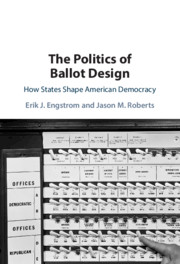58 results
Response to Benjamin I. Page and Martin Gilens’s Review of Race, Class, and Social Welfare: American Populism since the New Deal
-
- Journal:
- Perspectives on Politics / Volume 19 / Issue 1 / March 2021
- Published online by Cambridge University Press:
- 26 February 2021, pp. 225-226
- Print publication:
- March 2021
-
- Article
- Export citation
Democracy in America? What Has Gone Wrong and What We Can Do about It. Benjamin I. Page and Martin Gilens. Chicago: University of Chicago Press, 2020. 391p. $19.00 paper.
-
- Journal:
- Perspectives on Politics / Volume 19 / Issue 1 / March 2021
- Published online by Cambridge University Press:
- 26 February 2021, pp. 221-222
- Print publication:
- March 2021
-
- Article
- Export citation
6 - Reconsidering the American Ballot
-
- Book:
- The Politics of Ballot Design
- Published online:
- 27 November 2020
- Print publication:
- 17 December 2020, pp 130-141
-
- Chapter
- Export citation
List of Figures
-
- Book:
- The Politics of Ballot Design
- Published online:
- 27 November 2020
- Print publication:
- 17 December 2020, pp ix-x
-
- Chapter
- Export citation
1 - Introduction
-
- Book:
- The Politics of Ballot Design
- Published online:
- 27 November 2020
- Print publication:
- 17 December 2020, pp 1-14
-
- Chapter
- Export citation
4 - The Personal Vote Era, 1940–2000
-
- Book:
- The Politics of Ballot Design
- Published online:
- 27 November 2020
- Print publication:
- 17 December 2020, pp 59-91
-
- Chapter
- Export citation
3 - Ballot Architecture in the Progressive Era
-
- Book:
- The Politics of Ballot Design
- Published online:
- 27 November 2020
- Print publication:
- 17 December 2020, pp 37-58
-
- Chapter
- Export citation
Frontmatter
-
- Book:
- The Politics of Ballot Design
- Published online:
- 27 November 2020
- Print publication:
- 17 December 2020, pp i-iv
-
- Chapter
- Export citation
List of Tables
-
- Book:
- The Politics of Ballot Design
- Published online:
- 27 November 2020
- Print publication:
- 17 December 2020, pp xi-xi
-
- Chapter
- Export citation
Contents
-
- Book:
- The Politics of Ballot Design
- Published online:
- 27 November 2020
- Print publication:
- 17 December 2020, pp vii-viii
-
- Chapter
- Export citation
Dedication
-
- Book:
- The Politics of Ballot Design
- Published online:
- 27 November 2020
- Print publication:
- 17 December 2020, pp v-vi
-
- Chapter
- Export citation
Index
-
- Book:
- The Politics of Ballot Design
- Published online:
- 27 November 2020
- Print publication:
- 17 December 2020, pp 149-152
-
- Chapter
- Export citation
Bibliography
-
- Book:
- The Politics of Ballot Design
- Published online:
- 27 November 2020
- Print publication:
- 17 December 2020, pp 142-148
-
- Chapter
- Export citation
Acknowledgments
-
- Book:
- The Politics of Ballot Design
- Published online:
- 27 November 2020
- Print publication:
- 17 December 2020, pp xii-xiv
-
- Chapter
- Export citation
5 - Ballot Architecture in the Contemporary Partisan Era
-
- Book:
- The Politics of Ballot Design
- Published online:
- 27 November 2020
- Print publication:
- 17 December 2020, pp 92-129
-
- Chapter
- Export citation
2 - How the Ballot “Nudges” Voters
-
- Book:
- The Politics of Ballot Design
- Published online:
- 27 November 2020
- Print publication:
- 17 December 2020, pp 15-36
-
- Chapter
- Export citation

The Politics of Ballot Design
- How States Shape American Democracy
-
- Published online:
- 27 November 2020
- Print publication:
- 17 December 2020
Copyright page
-
- Book:
- Race, Class, and Social Welfare
- Published online:
- 07 July 2020
- Print publication:
- 16 July 2020, pp iv-iv
-
- Chapter
- Export citation
Bibliography
-
- Book:
- Race, Class, and Social Welfare
- Published online:
- 07 July 2020
- Print publication:
- 16 July 2020, pp 188-196
-
- Chapter
- Export citation
Dedication
-
- Book:
- Race, Class, and Social Welfare
- Published online:
- 07 July 2020
- Print publication:
- 16 July 2020, pp v-vi
-
- Chapter
- Export citation



